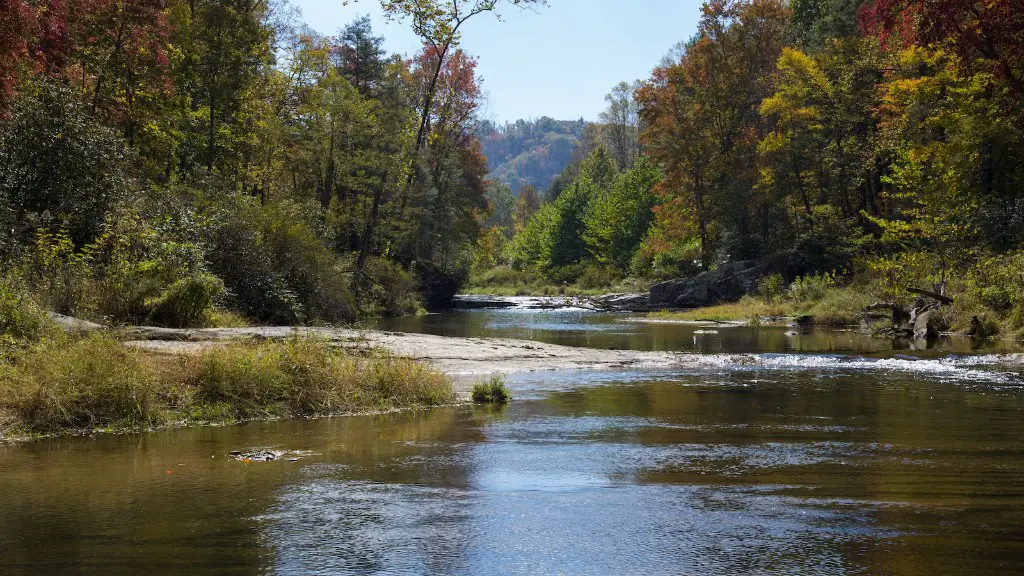The Mississippi River is one of the most important waterways in the United States and beyond, supplying drinking water, irrigation, transport and commerce to millions. However, in recent years, it’s been getting harder and harder for the river to maintain its flow and water levels – and for much of the time, it’s been slowly drying up.
This is a worrying trend, particularly for those who depend on the river for their livelihoods and the many communities that have built up around it. To get to the bottom of this issue, it’s important to look at the science of climate change, as well as the impact that human activity has had on the river and its surrounding ecosystems.
Studies have found that the effects of climate change have caused the region to experience a much higher rate of evaporation and longer periods of drought, making it increasingly difficult for the river to maintain its flow. The slow erosion of wetlands in the river’s watershed is also affecting the river’s ability to absorb rainwater and maintain healthy levels. Meanwhile, increased water demand from industries, agriculture and human usage is putting further strain on its water supplies.
Furthermore, industrial pollutants, particularly those from upriver sources, have been seeping into the river, contaminating its waters and affecting its health. This is having a huge impact on the species living in and around the river, not to mention the local people whose livelihoods depend upon it.
The good news is that steps are being taken to address the issue. Governments and industry have been working together to reduce water demand and improve water efficiency. Meanwhile, a number of organisations are focused on restoring wetlands and replenishing freshwater resources in order to better manage the river’s flow.
In addition, pollution laws and regulations are being put in place to clean up industrial and agricultural runoff and protect the river’s fragile ecosystems. Finally, efforts are also being made to raise public awareness of the issue and encourage everyone to do their part to help maintain the river’s health and vitality.
Alternative Water Supplies
In light of the drying up of the Mississippi River, communities and businesses along the Mississippi have been turning to alternative water supplies to make up for the lost volume. In some cases, water is being piped in from other rivers and reservoirs, while in some cases, people are digging private wells for their own supply. This has made the maintenance of the river’s flow even more important, as these alternative sources may not be able to provide enough water for everyone who relies on them during times of shortage.
In addition, it is also essential that alternative water supplies are properly monitored and regulated to ensure that they do not compromise the quality of water or harm the environment. This is especially important if the water is coming from sources such as reservoirs, as it may contain pollutants or bacteria which can be harmful if ingested or cause damage to ecosystems.
Finally, municipal authorities must ensure that the cost of providing alternative water supplies is not so great that it makes them inaccessible to those in need. This is essential in order to ensure that the availability of clean water is not restricted to only the wealthiest members of society.
Climate Change Adaptation Strategies
In order to ensure the long-term sustainability of the river and its surrounding ecosystems, it is important for governments and businesses to come up with effective climate change adaptation strategies. This includes the development of water resource management plans to help ensure that there is sufficient water for everyone in times of crisis, as well as the development of policies and regulations to help protect ecosystems and species from the impacts of a changing climate.
Monitoring programmes are also necessary to ensure that the health of the river is not compromised further by human activities, and that the changes taking place due to climate change are adequately monitored and responded to. Finally, it is also essential that efforts are made to raise public awareness of the need to take action against climate change, as this will be crucial in ensuring that the river remains healthy in the future.
Impact On Local Communities
The big question on everyone’s mind is how the drying up of the Mississippi River will affect local communities. The truth is, this is an incredibly complex issue, and there is no easy answer. In many cases, communities have been able toadapt to the changes in water availability and have managed to find alternative sources of water. However, this is not always the case, and in some areas, the drying up of the river has had a dramatic impact on the local population.
In many cases, this has meant the loss of livelihoods, as businesses and farms which relied on the river have been forced to close. It has also had a huge impact on the local environment, with wildlife populations being decimated and the ecology of the region being disrupted. Finally, it has also had a major psychological impact on the local population, as the drying up of the Mississippi River has had a significant cultural impact on many of the communities which have built up around it.
Restoration Projects
Fortunately, there are several initiatives and projects aimed at restoring the river’s flow, as well as its health and vitality. This includes the restoration of wetlands and riverside ecosystems, as well as the promotion of the adoption of sustainable agricultural practices. In addition, the federal government has also been working to protect the river from industrial pollution, while local communities have been coming together to oppose any proposed developments which could damage the river’s health.
Furthermore, education programmes are also underway to encourage people to do their part to ensure that the river remains healthy for generations to come. This includes educating people about the importance of conserving water and preventing pollution.
Finally, local governments and businesses have also been designing better ways to manage water resources and ensure that the river’s flow is maintained in times of drought and shortage. This includes the construction of dams, reservoirs and other large-scale infrastructure projects, as well as the adoption of new technologies and methods to improve water efficiency and reduce demand.
Community Engagement
The success of these restoration projects has been largely dependent on the involvement of local communities and stakeholders. By involving all those affected by the river in the decision-making process, it is possible to ensure that those living and working along the Mississippi River are able to voice their concerns and have their voices heard.
This is essential not only to ensure that the projects are successful, but also to ensure that all stakeholders are able to benefit from them. This is especially important for those who rely on the river for their livelihoods, as their involvement will ensure that the river remains healthy and usable for many years to come.
Public Perception
It is also important to consider the public’s perception of the issue. The drying up of the Mississippi River is a troubling trend, and it is essential that people are made aware of the problem and understand its implications. This will help to ensure that people understand the implications of human activities on the river and the wider environment and encourage them to do their part to help protect it.
This can be done through public education campaigns, grassroots activism and the development of better policies and regulations to protect the river and its surrounding environment. By raising awareness and understanding, it is possible to ensure that the river is properly safeguarded for generations to come.





